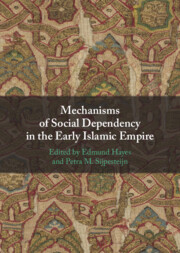Book contents
- Frontmatter
- Contents
- List of Illustrations
- List of Tables
- List of Contributors
- Notes on Transliteration, Place Names, Dates, Editions, and Translations
- Acknowledgments
- Introduction: The Ties that Bound the Societies of the Islamic Empire
- Part I Personal ties
- Part II Institutions
- Part III Communities
- 12 Local Elites during Two Periods of Civil Strife: Al-Ashʿath b. Qays, Muḥammad b. al-Ashʿath, and the Quarter of Kinda in Seventh-Century Kufa
- 13 Rulers, Ḥanābila, and Shiʿis: The Unravelling Social Cohesion of Fourth/Tenth-Century Baghdad
- 14 Resistance to and Acceptance of the Fatimids in North Africa: A Shiʿi Dynasty in Negotiation with Both Adherents and Enemies
- 15 Boundaries That Bind? Pagan and Christian Arabs between Syriac and Islamic Strategies of Distinction (Late First Century AH)
- 16 “Peace Be upon You”: Arabic Greetings in Greek and Coptic Letters Written by Christians in Early Islamic Egypt
- 17 Tied to Two Empires: The Material Evidence of the Islamic Conquest of Sicily
- Index
14 - Resistance to and Acceptance of the Fatimids in North Africa: A Shiʿi Dynasty in Negotiation with Both Adherents and Enemies
from Part III - Communities
Published online by Cambridge University Press: 06 December 2024
- Frontmatter
- Contents
- List of Illustrations
- List of Tables
- List of Contributors
- Notes on Transliteration, Place Names, Dates, Editions, and Translations
- Acknowledgments
- Introduction: The Ties that Bound the Societies of the Islamic Empire
- Part I Personal ties
- Part II Institutions
- Part III Communities
- 12 Local Elites during Two Periods of Civil Strife: Al-Ashʿath b. Qays, Muḥammad b. al-Ashʿath, and the Quarter of Kinda in Seventh-Century Kufa
- 13 Rulers, Ḥanābila, and Shiʿis: The Unravelling Social Cohesion of Fourth/Tenth-Century Baghdad
- 14 Resistance to and Acceptance of the Fatimids in North Africa: A Shiʿi Dynasty in Negotiation with Both Adherents and Enemies
- 15 Boundaries That Bind? Pagan and Christian Arabs between Syriac and Islamic Strategies of Distinction (Late First Century AH)
- 16 “Peace Be upon You”: Arabic Greetings in Greek and Coptic Letters Written by Christians in Early Islamic Egypt
- 17 Tied to Two Empires: The Material Evidence of the Islamic Conquest of Sicily
- Index
Summary
How the Fatimids, locally considered foreign easterners and heretical Shiʿa, negotiated sufficient acceptance in the Maghrib to withstand fierce opposition from Maliki Sunnis and Ibadi Kharijis, raises key issues concerning the formation of Islamic empires. Despite a plethora of enemies among the population, their rule endured and even prospered. What we know has grown substantially with new sources about the interaction of Ismaili authorities with the local ʿulamāʾ and the inner dynamics of their daʿwa and its allocation of restricted knowledge to members. Conversion of sections of the local elite and the demotion or expulsion of hostile elements helped. An internal document preserved by the daʿwa explains how its adherents were expected to prove their loyalty and the reward for doing so. The Ismailis existed both as one component in the new society and yet also remained apart as a community of Believers within the broader society of Muslims.
- Type
- Chapter
- Information
- Mechanisms of Social Dependency in the Early Islamic Empire , pp. 401 - 422Publisher: Cambridge University PressPrint publication year: 2024
- Creative Commons
- This content is Open Access and distributed under the terms of the Creative Commons Attribution licence CC-BY-NC-ND 4.0 https://creativecommons.org/cclicenses/

